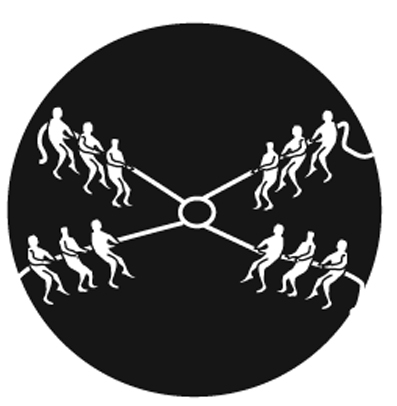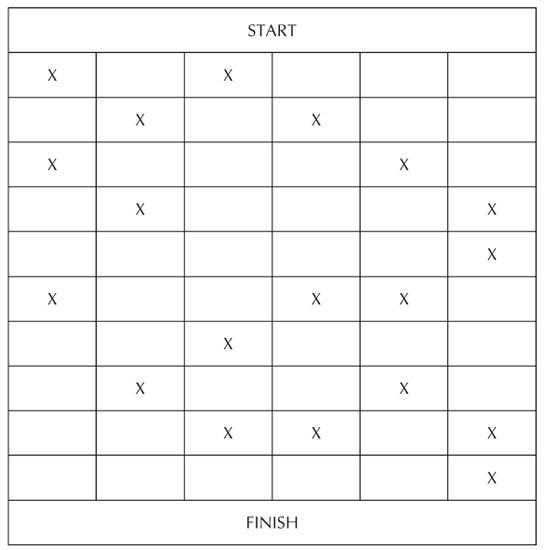

The following games and puzzles are ‘active’ games that often involve activities that may feel ‘adventurous’ but can be carried out in centres, in playgrounds, in parks or on playing fields without specialist staff. Many of them need considerable preparation, including collecting necessary resources and equipment, but this shouldn’t deter you. The outcome is worth the effort!
Problem-solving games are fun, cooperative, challenging games in which the group is confronted with a specific problem to solve. The activities bring out young people’s communication skills, as well as encouraging leadership, teamwork, decision making and initiative, which help to promote emotional and psychological growth, and they demonstrate a process of thinking about actions and consequences that helps participants learn how to reflect on an experience and learn from it. Problem-solving is an absolutely crucial life skill for everyone, whatever their age, status, position or background. Fortunately, it is a skill that can be learned over time and with practice; these activities allow individuals to learn, practice and make mistakes in an environment that is safe for them physically, emotionally and psychologically, helping them to develop their identity, capacity and character with which they will manage their life.
Reviewing the activity and the way that it was executed is a crucial stage of the learning process, as individuals need to recognise the approaches that do and do not work. For example:
All of these activities should be reviewed properly and debriefed to attain the maximum learning from them. As with all activities, review points should be embedded in the course of the activity, not left to the end as an ‘add-on’ before going home.
Equipment: tape or rope to mark the ends of the ‘river’ and some mats, cardboard or other material to create ‘islands’
The whole group must get from one end of the ‘river’ to the other. The group gets half as many ‘islands’ as there are people in the group. The whole group must be off one shore and onto the ‘islands’ before anyone moves onto the other shore. There are penalties for anyone who ‘dips’ into the river (such as going back to the beginning, the whole group starts over, that person must be silent, etc.).
Equipment: blindfold and tent
The goal is to pitch a tent with every member bar one blindfolded. The person without the blindfold calls out direction to the others. Alternatively, every team member can be blindfolded, but beware of damage to the tent!
Equipment: newspaper squares large enough for one person to stand on, with five more newspaper squares than the number of people (vibrant music can add a touch of drama!) Rules:
Put all the newspaper squares on the floor, spaced randomly. Ask all the participants to stand with both feet in a square. The ‘switching’ and ‘moving’ to new squares shouldn’t be a problem at this stage, because there are more than enough newspaper squares for everyone. After about three ‘switches’, begin to remove squares as you walk around the room; keep on taking newspaper squares away until there are not enough squares for everyone.
Leave the group for a while to see if they can work out that there may be more than one person per square.
Equipment: three mats per three participants in the group and rope to mark off the ends of the ‘minefield’
Split the participants into groups of three. Each group has to work together to cross the minefield as quickly as possible without touching the ground. If any of the team touches the ground, they must start again. The winning team is the one that reaches the finish and clears all their mats from the minefield the quickest.
Once the group has the idea of the activity, they can work in larger groups. It adds an interesting challenge to give out fewer squares than there are people in the group.
Note: this may be played with upturned crates/boxes.
Equipment: ropes tied to a central ring
Several teams pull against each other, requiring communication and tactics as well as strength to outmanoeuvre the opposition and win.
Lay out the ropes in a spider shape, with the ropes stretched out from the central ring. Divide the participants into groups of similar strength.
Safety rules:
The first command from the facilitator is ‘take the strain’. This is only to take up the slack. The leader makes sure the centre ring is stable and centred.
The second command is ‘Go!’
The teams attempt to pull the centre ring or knot over their finish line. This can rarely be achieved by strength alone but requires cunning and strategy.
Equipment: a piece of paper and a pen for each person The entire group sit on chairs in a circle, with nothing inside the circle. Each person writes down the name of another person in the group – they can only write down one name. Everyone folds their piece of paper and puts it in their pockets.
On the word ‘go’, each person has two minutes to persuade that person to make that person their partner. When everyone has their partner, they sit next to one another in the circle.
Only pairs are allowed.
Equipment: a length of rope and a blindfold for each member of the group
The blindfolded group follows the line, which has been laid out in advance around, through, under and over various objects.
The first person relays a description of the terrain and obstacles to the person behind, who passes it to the person behind, and so on down the line. It is always interesting at the end to compare what was said at the start of the line and what was heard at the end!
Equipment: flipchart paper, pens, a stopwatch, copies of the score clarifying sheet and the score sheet
The game is that each team must pick red or blue. The significance of each choice is in the way the points are scored. The objective for each team is to finish with a positive score. The game is played over 10 rounds of 2 minutes.
Divide the group into two teams. Each team needs to be out of sight and hearing of the other (preferably in separate rooms or out of sight of each other outdoors). Give each team a score clarifying sheet and a score sheet.

The only way to finish with a positive score is if both groups choose red every time. The aim of the game is to demonstrate the importance of trust: choosing red runs the risk that the other team will choose blue, in which case the team ends up with –6 and the other team with +6. The perceived safe option is to choose blue, so as not to be ‘beaten’ by the other team.

Equipment: a piece of drainpipe or guttering for each person in the group, a ball, a post, a bucket
This game is best played in an open space where the bucket and post can be placed a good distance apart. The players must move the ball from the post to the bucket without carrying or touching it.
Rules:
Additional challenges may be added, for example:
Equipment: a length of rope, knotted or fastened securely at the ends to form a circle All the group except one takes hold of the rope, holds it about waist height and leans backwards, so that the rope makes a taut circle. The remaining group member climbs onto the rope and walks around the whole circle on it.
Equipment: several ropes, two trees or substantial posts spaced a couple of metres apart (and helmets if the web is to be above shoulder height) With the ropes, form a web with varying sized holes. All group members must pass through the web from one side to the other without touching the ropes forming the web.
Rules:
Facilitator note: you will need enough time to prepare and test the web before using it!
Equipment: planks of various sizes (for a group of 8 people, one long plank and two short planks are adequate), several mats or tyres and a rope to outline the marsh The group must work as a team and cross the acid marsh taking all the equipment with them.
Rules:
Additional challenges may be added:
Equipment: masking tape and a replica of your maze design on paper (for the facilitator!) Mark the maze out on the floor with the masking tape; the blocks should be around 30cm × 30cm (big enough for one person to step into).
The paper maze replica will have ‘hot spots’ marked out, which should form a route through the maze; there may be two ‘entrances’, but one should be a dead end and the other should lead through to the other side. One side of the maze should be the start and the other side the end, such as in the sample maze below.

Ground rules:
Equipment: a copy of the ‘Zin Obelisk instruction sheet’ for each participant, a set of ‘Zin Obelisk information cards’ for the group (thirty-three cards per set) After the members have had time to read the instruction sheet, distribute the Zin Obelisk Information Cards randomly so that each participant gets an equal number of cards. Nobody is allowed to gather the cards in front of them, everyone should keep their cards but they can only share what is written on the card verbally. The answer is Neptiminus.
Rationale:

Equipment: a small bucket, a large bucket, a rope to mark out the radiation zone and a range of planks, ropes and bungees
The challenge is to move the toxic waste contents to the neutralisation container using minimal equipment and maintaining a safe distance within a time limit.
The challenge is for the group to work out how to transfer the toxic waste from the small bucket into the large bucket where it will be ‘neutralised’, using only the equipment provided and within a set time. The waste will blow up and destroy the world after 20 minutes if it is not neutralised.
Anyone who ventures into the radiation zone will suffer injury and possibly even death, and spillage will create partial death and destruction. Therefore, the group should aim to save the world and do so without injury to any group members.
The rope circle represents the radiation zone emanating from the toxic waste in the bucket. Emphasise that everyone must maintain a distance from the toxic waste wherever it goes, otherwise they will suffer severe injury, such as loss of a limb or even death.
Setting up:
Equipment: one mat per person, plus one extra for the centre The aim is for two equal teams to exchange places on a line of shapes that has one more place than the number of people in both groups.
Rules:
Illegal moves:
Equipment: tyres (decreasing in size or the same size but numbered sequentially), arranged in a pyramid, and three flat wooden posts
The group must re-build the pyramid, moving it one tyre at a time from one side to the other (either in decreasing size order or number order).
Rules:
Additional challenge: encourage the group to lift the tyres as a team without touching the post.